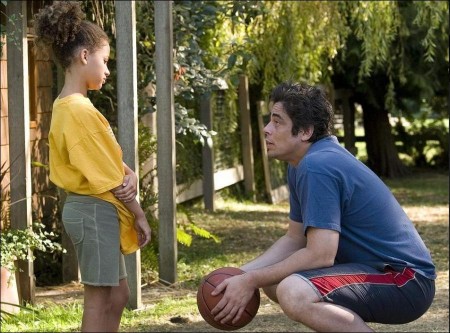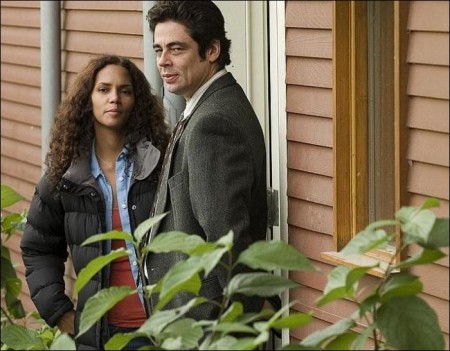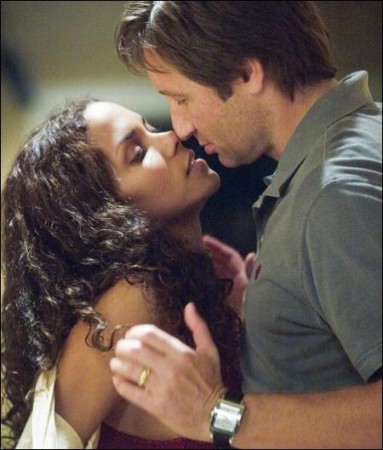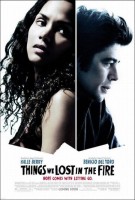Hope comes with letting go.
After her husband dies in an act of senseless violence, Audrey Burke (Halle Berry) is left alone with two young children and no idea how to cope. Nearly paralyzed by grief, Audrey tracks down her husband’s childhood friend, Jerry (Benicio Del Toro) . Jerry is a drug addict, but Audrey invites him to move into her home nevertheless, and a mutually dependent relationship develops between the two damaged souls.
Academy Award winners Halle Berry and Benicio Del Toro star in director Susanne Bier’s (the Oscar-nominated “After the Wedding”) powerful new drama “Things We Lost in the Fire,” a moving and emotionally compelling drama about two people brought together by fate.
Audrey Burke (Berry) is reeling from the shock of the news that has just been delivered to her door by the local police: her warm and loving husband Brian (David Duchovny), the father of their two young children, has been killed in a random act of violence.
Once anchored by the love and comforts of their 11-year marriage, Audrey is now adrift. Impulsively, she turns to Jerry Sunborne (Del Toro), a down-andout addict who has been her husband’s close friend since childhood.
Desperate to fill the painful void caused by her husband’s death, Audrey invites Jerry to move into the room adjacent to their garage in the hope that he can help her and her children cope with their sudden loss. Jerry is facing a daily battle to stay off drugs, but in his unexpected role as surrogate parent and friend to Audrey’s son and daughter he finds a core of inner resilience. As Jerry and Audrey navigate grief and denial, their fragile bonds are constantly tested. Working together, however, they discover the strength to move forward.
Catharsis, Recovery and Friendship
With “Things We Lost in the Fire,” Danish director Susanne Bier is making her first American language film following worldwide critical acclaim for her character-driven films, including the 2006 Oscar nominee “After the Wedding” and two earlier films 2002’s “Open Hearts” and 2004’s “Brothers,” which was nominated for 11 European Film Academy awards. Bier’s straightforward but emotionally potent stories, which often hinge on the repercussions of unexpected events, have earned her a growing international audience -among those who had seen and admired her work was Academy Award-winning director Sam Mendes.
Following his success with “American Beauty” and “Road to Perdition,” director Sam Mendes’ production company was on the receiving end of Hollywood’s top new scripts and one of the projects he responded to immediately was “Things We Lost in the Fire” written by Allan Loeb. “It’s a very moving, touching original story,” he says. “It’s very rare to find movies that, on the one hand, are personal stories about human beings interacting, but on the scale necessary to be a motion picture as opposed to a piece for television.”
Mendes immediately decided to produce the project and went in search of the ideal director for the material. “I felt that it needed a very distinctive voice in terms of a director,” he says. “I wanted it to be as personal a piece of filmmaking as it was a piece of screenwriting. His producing instincts led him in the direction of Bier, whom he compares to Fernando Mereilles, Alejandro González Iñárritu and other talented contemporary filmmakers who’ve come from non-English speaking countries. “Like Susanne’s work, their movies tend to have a similar aesthetic… handheld, a little rougher, grittier and very distinctive…not as conventional as some equivalent moviemaking in this country and my native England,” he explains.
Bier, who was looking for a story to mark her American film debut, concedes that she felt some trepidation in choosing the right material. After reading many scripts, Bier responded to Loeb’s drama and the way in which it brought together two people who were struggling to cope with a devastating loss. “I’m always interested in what happens to people in extreme situations. I felt this story was familiar, but at the same time it made me curious…because it was about something that really could happen,” she says. “And I also loved the idea of working with Sam Mendes, which I thought would be stimulating and a lot of fun.”
Her one caveat was that she might not have the same latitude she enjoyed in her native land. “Coming to America, I was expecting that I would experience certain restraints, like being asked to make the movie more mainstream, but in fact it was quite the opposite,” she says. “I received comments like, `be more courageous, be more daring… make it more dangerous.'”
When asked what “Things We Lost in the Fire” is about, screenwriter Loeb always says the same thing: “It’s about catharsis and recovery,” he proclaims. “That’s all I say. That is what it’s about. But it’s also about friendship.”
Loeb had never seen Bier’s films before she came aboard as director. “But when I saw her films `Brothers’ and `Open Hearts,’ I was moved. They are both unbelievably powerful,” says Loeb. “As soon as I saw her work, I knew that `Things’ was right up her alley.”
Set in the Northwest, the story begins with married couple Audrey and Brian (Halle Berry and David Duchovny) enjoying a comfortable life with their two kids, ten-year-old Harper (Alexis Llewellyn) and six-year-old Dory (Micah Berry). Although their marriage is good, the one rift between them is Jerry (Benicio Del Toro), Brian’s close childhood friend, a lawyer whose life has deteriorated because of his drug dependence. Audrey doesn’t understand why her husband continues to extend himself to Jerry when everyone else in his life has abandoned him because of his self-destructive behavior.
But after Brian’s sudden death, Audrey invites Jerry to his funeral, partly out of guilt and partly in recognition of his lifelong friendship with her husband. From the dark abyss of her grief, she finds herself reaching out to Jerry as the only person who may have known and loved Brian as much as she did.
What Mendes found appealing about the story was its deceptive simplicity. “One of the great things is that it’s about a happy couple who are married with two children,” says Mendes. “And they have a very solid, unspectacular, ordinary life in a way, but it is special for them. And then one of them is unexpectedly killed.”
As a way of trying to maintain her connection with her late husband, “the wife digs back into his life story,” Mendes continues. “There has always been this friend of his she’s never met. His name is Jerry and he’s a drug addict. She decides to track him down. He is difficult and elusive and not always friendly. Somehow they become entangled — I mean psychologically, not necessarily romantically. And together they deal with the problems that they are facing.”
Assembling the Ensemble
As the focus turned to casting, Bier was thrilled to be able to attract talents like Benicio Del Toro (who had earned a Best Supporting Actor Oscar for “Traffic” in 2000) and Halle Berry (the 2002 Academy Award winner for Best Actress in “Monster’s Ball”) for the central roles of Jerry and Audrey.
“Halle and Benicio are both great actors,” says Bier. “They’re really interesting to watch and very original. I just thought it would be very exciting to put the two of them together. I could imagine a sexy, potentially aggressive chemistry between them, but also a sense of comfort…a kind of emotional recognition between the two of them, which I thought would be great.”
“We lucked out in that Benicio is a genius, really, and Halle is a fantastic actress who was really passionate about this role,” says Mendes. “And of course David Duchovny provides a great foundation as Brian, the character who really sets up the story.”
Both actors pursued Loeb and barraged him with questions about the characters they had agreed to play. “Benicio wanted to know everything,” according to Loeb. “He’s very detail oriented. And Halle did too. She wanted to know a lot about Audrey’s emotional journey. It was very interesting talking to them about it, because it was always about finding the truth. What’s the truth about where they’re coming from? What’s the truth of how they are feeling?”
Despite her popularity and Oscar pedigree, Berry admits that she fought for the role of Audrey Burke. “I think most actors have to fight for the good parts,” she says. “They’re so few and far between, especially for women.”
“Audrey wasn’t written as a black character,” she continues. “So I wasn’t the first thought on anybody’s mind. But very early on, I said to my manager, `I know the studio’s not thinking of me, but if I could just meet with the director…'”
Berry got her wish when Bier stopped in New York on her way to Denmark and met her for coffee. “I hoped maybe Susanne would be able to see outside the box,” explains Berry.
The director was well aware of Berry’s beauty, laughing as she recalled the times the actress would arrive on set “with no make-up, wet hair from the shower and still look like a goddess.”
But what made the most vivid impression was that “Halle’s an amazing actress and she brings a kind of intensity and anger to this role,” observes Bier. “At no time does she choose the safe way out.”
Describing the themes that attracted her to the story, Berry explains, “We often take our lives for granted…our lives and the things that we have. We covet things. But what’s really important is what we can’t even touch… the human spirit… having people we love in our lives.”
Del Toro did substantial research on drug addiction for his role. He also met with medical experts and attended Narcotic Anonymous meetings. “He got inside the head of the character and of anyone who has had an addiction,” says producer Sam Mercer. “He recognized that they are people and have to be treated with humanity. They’re suffering from a disease and you have to be human about it.”
In Jerry, Del Toro saw a character who was both childlike and nurturing. “I think it was Kurt Cobain who said something along the lines that people need to get high to feel the enthusiasm that they felt as a kid,” says Del Toro. But it’s Jerry’s natural rapport with his best friend’s children that does as much to stabilize his life and restore his spirits as it does theirs. “I think that children, without knowing it, can give someone a purpose,” he observes. “And they do give Jerry a purpose.”
Describing the unconventional relationship that emerges between Audrey and Jerry, Del Toro observes, “These are two handicapped people. It’s like the blind leading the blind in a way. Audrey is trying to deal with her grief, break out and move on, and Jerry is attempting to deal with a long-term addiction. There are ups and downs — it’s an emotional roller coaster.”
Despite the dark themes and emotionally charged scenes, Bier also made an effort to lace the story with humor and credits Del Toro with helping find the lightness in many scenes. “Benicio is naturally very funny,” she says. “And I think whatever he does is always going to be loaded with a great sense of humor. You can always color a scene, and you can color it with more or less humor, and he would, at any time, color it as humorously as he could.”
For the pivotal role of Brian, the man whose death propels the story forward, Bier approached the popular film and television actor David Duchovny, who immediately responded to the project. “The script is emotional and it’s smart,” he begins. “And it’s hard to find a good emotional movie that feels true in some way. It’s not melodramatic and yet it has some heavy emotion in it.”
In addition to creating a credible comfort level in their portrayal of a couple who have been married more than a decade and have two children, Berry and Duchovny also strove for imperfection. “They are an imperfect but very happy family,” says Berry. “When you’ve been married 11 years, there’s a certain normalcy, a certain routine. And there’s happiness in the security of that relationship.”
“There’s a kind of mixture of excitement and boredom there, which is what marriage can be like,” adds Duchovny. “We didn’t want it to be perfect, so it seemed more like a real tragedy. Life just ends unexpectedly. It’s not neat and nobody was ever perfect.”
Besides Jerry, Audrey and her children, Harper (Alexis Llewellyn) and Dory (Micah Berry), Brian’s death also impacts other characters in the film — both directly and indirectly. John Carroll Lynch plays Howard Glassman, a neighbor and close friend of Brian’s. “He and Brian ran together every day,” explains Lynch. “When Brian dies, Howard finds himself in a situation where he has to reassess his own life. He’s kind of asleep at the beginning of the movie and suddenly something happens to his friend and he has to wake up. That’s what’s wonderful about this story. The grief affects everybody differently. Some people change their lives, some people don’t.”
As Audrey’s brother Neal, Omar Benson Miller is called up to give solace to his older sister in her time of need and to help the troubled Jerry through a rough patch in his rehab process. “It’s a study in loss and in rebirth,” observes Benson Miller. “Through Brian’s passing, Audrey’s eyes are opened to what she can be and what she needs to go on with her life and the same is true for Jerry.”
Rounding out the cast is Alison Lohman as Kelly, an observant young woman who befriends Jerry at a Narcotics Anonymous meeting. “To me, this story is about the beginning of the recovery process,” says Lohman, whose character is farther along in her journey as a rehabilitated substance abuser. “For Jerry, it’s recovery from addiction; for Audrey, it’s from the death of her husband.”
“I really love Alison’s performance,” says Bier. “It’s very specific and she’s very sharp. As for the kids, it’s a biracial family and we wanted kids who would look convincingly like Halle and David but who were also special and wonderful kids — and we got that in Micah and Alexis.”
“What’s wonderful about the script,” adds producer Mercer, “is the success of how the kids are written. It’s hard to write kids. People usually write them as small adults with small adult problems. But that’s not the case here. These are children and they behave like children. They have children’s thoughts and expectations. And both Alexis and Micah play it beautifully.”
About the Physical Production
Bier, whose early works illustrated the principles of Dogma 95, an avantgarde filmmaking movement started in 1995 by Danish directors including Lars von Trier, is well known for the fluid movement of her camera.
“She uses handheld cameras, and she gets very, very close to people, sometimes into their eyeballs, you know, literally,” says an admiring Mendes. “She’s very free in rehearsals and watching her shoot, she’s got two cameras going most of the time. She moves with them. But her real study is human beings and the species.”
When filming began on location in Vancouver, Bier’s style of working with the actors was as radical and open as the movement of her camera. “We rehearsed the day’s scenes every morning for about one and a half to two hours,” explains Bier. “And we often changed a lot at that point. It’s a very creative process. And it demands a lot of responsibility, a lot of creativity from the actors.”
“The rehearsals were conducted in the environment of the house, which is the key set in the movie,” adds producer Mercer. “We would make lunch, dinner, and go out and play ball in the yard. That helped getting everyone comfortable, so when it came time to do the scenes, they were a unit.”
“The script is the script, and of course it’s the bible and we want to honor that,” says Berry. “But Susanne is a great advocate for taking the words and making them your own, saying basically what the writer intended, but putting it into you own body so that it sounds natural coming out of your mouth.
“Susanne did a terrific job of keeping everyone listening and open to exploring different interpretations of the different moments in a scene,” Berry continues. I have proposed things and she’s taken them and run with them. It’s been great in that way. It feels like we’re all on the same page.”
“I don’t believe in preconceived scenes,” explains Bier. “I believe in knowing a lot about what the scene is about, but I also believe in being open, because great actors — and these are great actors — have an immense interaction and an immense knowledge of their own characters. We never know when we get there in the morning what the day’s going to be, what the scenes are going to be, and that’s fun and it’s exciting…and it’s terrifying.”
The element of trust the actors had in the director also extended to their co-stars. “The other actors you’re working with always influence you,” says Berry. “And usually they make you better. You can really help make each other better by being present in the moment and really understanding your own character and always making choices. Benicio’s very much like that. He has definite ideas about who he is as an actor and about the character. You have to respect that and you work with him on that.”
Del Toro found working with Berry equally beneficial. “With Halle you just listen. There’s not a false beat in her. So all you have to do is be there and watch what’s going on.”
Although dialogue may have changed in the course of production, what remained consistent was that handheld cameras were always in motion as part of Bier’s signature style. To collaborate with her as the film’s cinematographer, Mendes suggested Tom Stern. “Tom was the gaffer on `American Beauty’ and `Road to Perdition’,” explains Mendes. “He worked very closely with Conrad Hall, who was the great cinematographer on those movies, and he was given his first chance as director of photography by Clint Eastwood on `Blood Work’.”
Stern’s subsequent collaboration with Eastwood has resulted in such acclaimed films as “Million Dollar Baby,” “Flags of Our Fathers” and “Letters from Iwo Jima.” “Tom had to light all the sets 360 degrees because we were literally shooting in all directions in various takes,” explains Bier. “So it does put a lot of demands on the crew. There’s very little space for the crew to stand around, you know? Everybody was hiding behind the chairs and there were no safe islands. But that intensity also gives a lot.”
“We did not waste time on this movie setting up sticks, or putting cameras on sticks or dollies,” laughs Berry. “But there’s this organic feel that the movie is always in motion, almost documentary-like in a way.”
“Susanne is both behind the monitor and very involved in the meaning and the pace of the scene,” says Duchovny. “She’s all over every part of it. It’s her movie and she’s taking responsibility for it.”
Much of the filming took place in a local Vancouver home, an architecturally open layout with angled walls of glass that provided great visuals as well as daily challenges for production designer Richard Sherman (“Kinsey,” “Running with Scissors”) and his team.
Producer Sam Mercer (“Jarhead,” “The Sixth Sense”) suggests that both Bier and the movie set kept the crew on their toes. “The actors had the freedom to move around and to explore their characters, but Susanne could tap the camera operator on the hand and have him pan the camera unexpectedly. So the crew had to approach how they blocked a scene, how they technically lit a scene and often where they hid during the scene.”
Production notes provided by DreamWorks Pictures.
Things We Lost in the Fire
Starring: Halle Berry, Benicio Del Toro, David Duchovny, Alison Lohman, Alexis Llewellyn, Robin Weigert
Directed by: Susanne Bier
Screenplay by: Allan Loeb
Release Date: October 26, 2007
MPAA Rating: R for drug content and language.
Studio: DreamWorks Pictures
Box Office Totals
Domestic: $3,287,315 (38.7%)
Foreign: $5,217,428 (61.3%)
Total: $8,504,743 (Worldwide)




